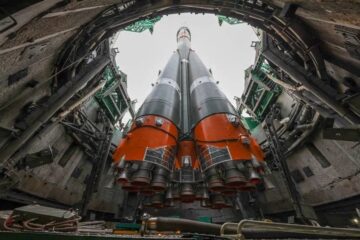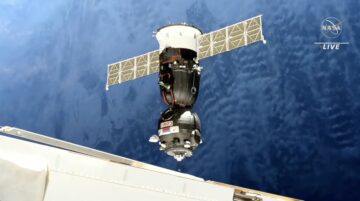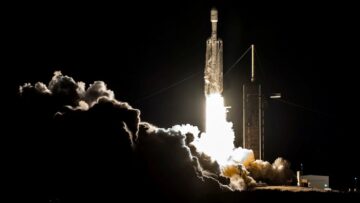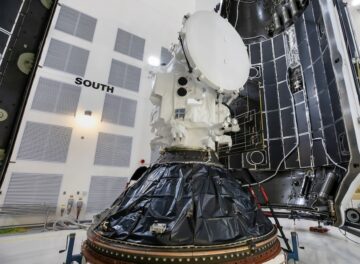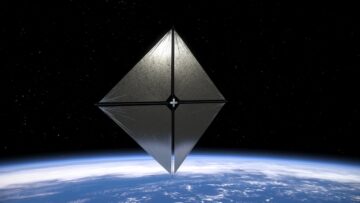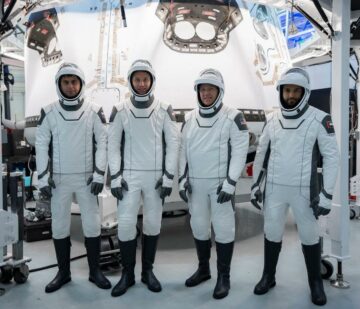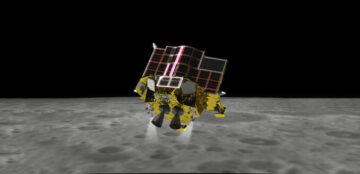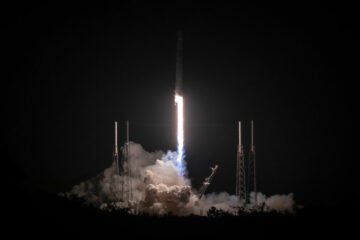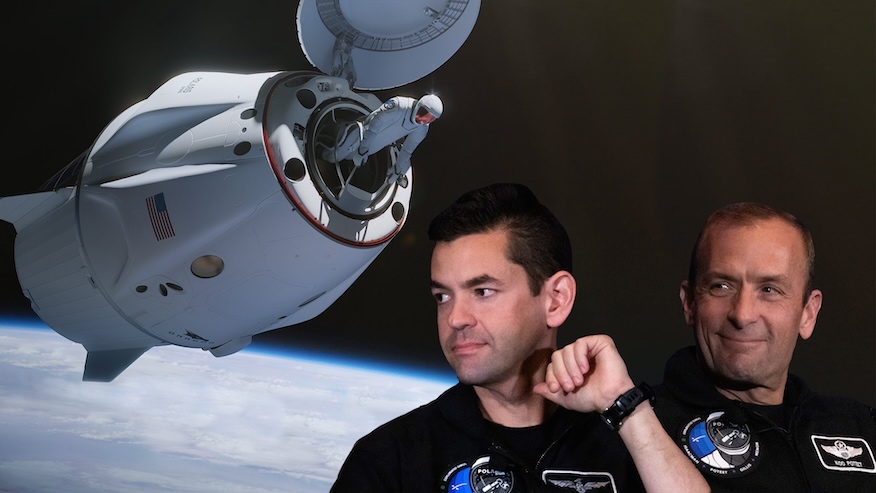
Amid a flurry of astronaut missions scheduled for 2024, a commercial flight is aiming to mark a historic first: a non-governmental spacewalk.
This is just one of the goals of the Polaris Dawn mission, which was announced back in 2022. The mission’s commander, entrepreneur and commercial astronaut Jared Isaacman, began working towards this mission shortly after the conclusion of his first spaceflight in 2021.
The Inspiration4 flight was a remarkable mission in its own right, as it became the first launch of an all-civilian group of astronauts, none of whom were current or former employees of a nation-state’s astronaut corps.
Isaacman and the mission’s pilot, Scott “Kidd” Poteet, recently sat down with Spaceflight Now to discuss the Polaris Dawn undertaking.
[embedded content]
“This time around, there’s a lot of emphasis on our kind of specific objectives, the altitude, especially the EVA (extravehicular activity) and the new suit development,” Isaacman said. “And unlike being there at the end where they say ‘Here’s your suit,’ we get to be there through every iteration of it, you know, starting with an IVA (intra-vehicular activity) suit that’s not really suitable for going outside the vehicle, to what we have now, which is getting close to the flight article.”
Isaacman said in a social media post on Saturday that they have a target date, but they “still have a lot to get through with development and training.” The Polaris Dawn website stated that the mission is set for “no earlier than early 2024.”
We have a target date, but still a lot to get through with dev and training. Qualification & acceptance tests on hardware w/ probably the biggest milestone the EVA suit ATP’s. We are getting much closer.
— Jared Isaacman (@rookisaacman) January 27, 2024
Isaacman and Poteet will spend about five days on orbit for this free-flying mission with their two crew mates, Mission Specialist Sarah Gillis and Mission Specialist/Medical Officer Anna Menon. All four were connected through their work on the Inspiration4 mission before they became a crew on Polaris Dawn.
“Sarah Gillis was a lead astronaut trainer for that program. So, we got very close over six months,” Isaacman said. “She was the ‘core,’ so she was the first voice we heard when we strapped into Dragon and the voice we heard going all the way up to space. So, a lot of trust there.”
“Anna Menon is a lead mission director at SpaceX. She runs Mission Control,” he added. “She was assigned to our families, to be the one to translate the good and, if necessary, the bad news to them. That’s a position of a lot of trust. And then obviously, Kidd was the mission director on it.”

During the mission, the four-member crew will conduct 38 experiments from 23 institutions from around the world in addition to raising funds for St. Jude Children’s Research Hospital.
The other two benchmarks of success for this flight include taking the SpaceX Dragon spacecraft to a higher orbit than any previous Dragon mission as well as using the Starlink internet constellation to demonstrate laser-based communications while on orbit.
In a series of social media updates on Friday and Saturday, Isaacman answered some questions from the public about the progression of the suit development and the mission overall. He stated that over the past week, they “spent a lot of time pressurized in the EVA suits working contingencies.”
Isaacman clarified as well that, unlike missions to the International Space Station chartered by either NASA or Axiom Space, the crew members of the Polaris Dawn mission won’t launch and land while wearing IVA suits. He said because they are limited with space on this flight, they will only have their EVA suits.
In his conversation with Spaceflight Now, he added that their ride to space and back, the Crew Dragon Resilience, will have some extra demands placed on it to support the planned spacewalk.
“It’s not an airlock that has to be qualified to vacuum, it’s the entire spaceship that has to be done,” Isaacman said. “You’re also going to be using consumables at a substantially higher rate than you were before because you’re using oxygen for cooling. So, you need a lot more tanks than a Dragon would typically be equipped for, plus, the air to re-pressurize it. So, a lot goes into that.”
He stated on social media that SpaceX and the Polaris Dawn team are “using the center pallet for additional tanks” to help bolster the redundancies of the Dragon’s environmental control and life support system (ECLSS).
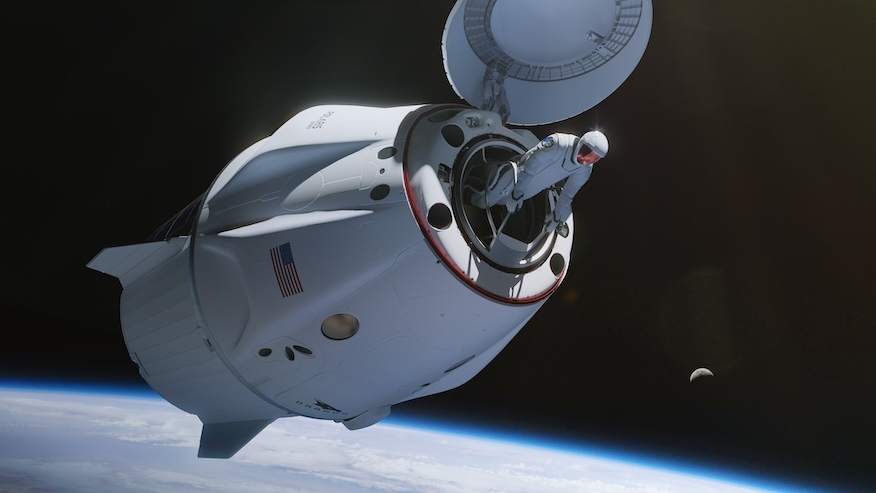
“Wicked fast”
The development of extravehicular activity (EVA) suits is no small undertaking. NASA awarded contracts to both Axiom Space and Collins Aerospace to develop suits that are suitable for deployment on the surface of the Moon and ones designed for operation outside of the ISS.
The EVA suits being developed by SpaceX will likely be closer to the variants used for work outside of the orbiting outpost. However, SpaceX has been extremely tight-lipped about their development.
Isaacman described the EVA suits as “heavier and bulkier” as compared to the IVA version he used during Inspiration4. However, he clarified that it’s because the EVA suit needs to support additional capabilities.
“The reality is that SpaceX’s pace of development on building an EVA suit is wicked fast right now. And you know, you start with an IVA suit that’s already certified, which is has, under pressure, very little mobility,” Isaacman said. “There’s no mechanical joints in it and it’s a last line of defense. You’re only using that if everything else around you in the spacecraft failed into an environment where you are throwing away all the safety of your spacecraft and all the redundancies that are built into it. And now all you have is a suit.”

SpaceX and the Polaris Dawn team have shared some images of the training process. Poteet said it’s been quite something to go through these paces compared to his prior training in the U.S. Air Force.
“You know, back in pilot training, we were still using devices and procedures that they were using in the 1950s, 60s, 70s,” Poteet said. “Here, they’re creating thee training devices to simulate something that’s very difficult to simulate: zero gravity, with certain harnesses and, you know, these different monster garage-type devices to offload some of the challenges associated with, you know, being at 1G trying to simulate this whole EVA.”
As of mid-December, Isaacman said they were about 70 percent of the way to their mission launch goal based off their starting point roughly two years ago. He said once SpaceX is able to bring its EVA suits online, that will be a big step forward in the company’s future celestial ambitions.
“This is important. They envision a future that’s more exciting, where people can journey among the stars. You’re going to need a lot of spacesuits,” Isaacman said. “They shouldn’t cost hundreds of millions. They should cost a lot less. They should be scalable.”
Learning from the past, preparing for the future
Isaacman’s latest updates on the Polaris Dawn mission come on Jan. 27, 57 years after the fire that killed Virgil I. “Gus” Grissom, Edward H. White II and Roger B. Chaffee amid a pre-launch test for the Apollo 1 mission.
Sunday, Jan. 28, marks the 38th anniversary of the Challenger disaster.
The team remains acutely aware of the risks of pushing the envelope with human spaceflight, which is why Isaacman said they try to keep the lessons of the past in the forefront of their minds.
“The early days of the space program with the cosmonauts and, you know, Ed White went through and other astronauts was like, I mean, their masks fogged over, they could barely get back into the Gemini spacecraft,” Isaacman said. “I mean, there is a lot of lessons that were learned that have to be applied to this suit. And [SpaceX has] done it incredibly fast with a lot of testing and development.”

Once they’re able to demonstrate the viability of the suits with the Polaris Dawn mission, Isaacman said the hope is to be able to support repairs and boosting the Hubble Space Telescope on the second Polaris Program mission.
“That’s in NASA’s hands to decide if they want us to touch their telescope. I’d say the risk/reward is pretty favorable for it, not to mention that it builds awesome capabilities for commercial space that’s going to be required for the future,” Isaacman said during a panel discussion at the Space Force Association’s Spacepower Conference in December.
The third mission is slated to be the first crewed launch of a Starship rocket. Prospective dates for either of the two follow-up missions have not been made public.
In the meantime, Isaacman and Poteet both said they’re enjoying the ride so far and aren’t looking past this first mission.
“I absolutely love every moment that we’re training. You know, we get closer and closer to launch, so we achieve these milestones and it’s kind of like these holy shit moments when we’re in the capsule and we’re just like, wow, here’s the crew, this is where we are in this phase of flight. And it becomes more and more real. As we get closer to launch itself.”
- SEO Powered Content & PR Distribution. Get Amplified Today.
- PlatoData.Network Vertical Generative Ai. Empower Yourself. Access Here.
- PlatoAiStream. Web3 Intelligence. Knowledge Amplified. Access Here.
- PlatoESG. Carbon, CleanTech, Energy, Environment, Solar, Waste Management. Access Here.
- PlatoHealth. Biotech and Clinical Trials Intelligence. Access Here.
- Source: https://spaceflightnow.com/2024/01/31/polaris-dawn-astronauts-discuss-training-for-historic-commercial-spacewalk/
- :has
- :is
- :not
- :where
- $UP
- 1
- 2021
- 2022
- 2024
- 23
- 27
- 28
- 678
- 70
- a
- Able
- About
- absolutely
- acceptance
- Achieve
- activity
- Adam
- added
- addition
- Additional
- Aerospace
- After
- ago
- Aiming
- AIR
- Air Force
- All
- alongside
- already
- also
- ambitions
- Amid
- among
- an
- and
- anna
- Anniversary
- announced
- any
- apollo
- applied
- ARE
- around
- article
- AS
- assigned
- associated
- astronaut
- At
- awarded
- aware
- away
- b
- back
- Bad
- based
- BE
- became
- because
- becomes
- been
- before
- began
- being
- benchmarks
- Big
- Biggest
- bolster
- both
- bring
- Building
- builds
- built
- but
- by
- california
- CAN
- capabilities
- Center
- certain
- Certified
- challenger
- challenges
- Chartered
- clarified
- Close
- closer
- Collins
- collins aerospace
- come
- commercial
- Communications
- Company’s
- compared
- conclusion
- Conduct
- conducts
- Conference
- connected
- content
- contracts
- control
- Conversation
- corps
- Cost
- could
- Creating
- crew
- Current
- Date
- Dates
- Days
- December
- decide
- Defense
- demands
- demonstrate
- demonstrates
- deployment
- described
- designed
- Dev
- develop
- developed
- Development
- Devices
- different
- difficult
- Director
- disaster
- discuss
- discussion
- done
- down
- Dragon
- during
- Earlier
- Early
- ed
- Edward
- either
- else
- embedded
- emphasis
- employees
- end
- enjoying
- Entire
- Entrepreneur
- envelope
- Environment
- environmental
- envision
- equipped
- especially
- Ether (ETH)
- Every
- everything
- exciting
- Exiting
- experiments
- extra
- extremely
- Failed
- families
- far
- FAST
- favorable
- Fire
- First
- five
- flight
- flurry
- For
- Force
- forefront
- Former
- Forward
- four
- Friday
- from
- funds
- future
- Gemini
- get
- getting
- Go
- goal
- Goals
- Goes
- going
- good
- got
- graphic
- gravity
- Group
- Hands
- Hardware
- harnesses
- Have
- he
- Headquarters
- heard
- help
- High
- higher
- his
- historic
- holy
- hope
- Hospital
- However
- http
- HTTPS
- Hubble
- human
- Hundreds
- hundreds of millions
- i
- if
- ii
- image
- images
- important
- in
- include
- incredibly
- Inspiration4
- institutions
- International
- international space station
- Internet
- into
- ISS
- IT
- iteration
- ITS
- itself
- Jan
- journey
- jpg
- just
- just one
- Keep
- Kind
- Know
- Land
- Last
- latest
- Latest Updates
- launch
- lead
- learned
- left
- less
- Lessons
- Life
- like
- likely
- Limited
- Line
- little
- looking
- Lot
- love
- made
- mark
- Masks
- max-width
- mean
- meantime
- mechanical
- Media
- Members
- mention
- milestone
- Milestones
- millions
- minds
- Mission
- Mission Control
- missions
- mobility
- moment
- Moments
- months
- Moon
- more
- much
- Nasa
- necessary
- Need
- needs
- New
- news
- no
- None
- now
- objectives
- of
- off
- Officer
- on
- once
- ONE
- ones
- online
- only
- operation
- or
- Orbit
- orbiting
- Other
- our
- outside
- over
- overall
- own
- Oxygen
- Pace
- panel
- panel discussion
- past
- People
- percent
- performed
- phase
- pilot
- placed
- planned
- plato
- Plato Data Intelligence
- PlatoData
- plus
- Point
- position
- Post
- preparing
- pressure
- pretty
- previous
- Prior
- probably
- procedures
- process
- Program
- progression
- prospective
- prototype
- provide
- public
- Pushing
- qualification
- qualified
- Questions
- quite
- raising
- Rate
- real
- Reality
- really
- recently
- remains
- remarkable
- render
- rendering
- repairs
- required
- research
- resilience
- Ride
- right
- risks
- rocket
- roughly
- runs
- s
- Safety
- Said
- saturday
- say
- scalable
- scheduled
- scott
- Second
- Series
- set
- shared
- she
- Shortly
- should
- simulate
- simulation
- SIX
- Six months
- small
- So
- so Far
- Social
- social media
- some
- something
- Space
- Space Force
- space station
- spacecraft
- spaceflight
- SpaceX
- specialist
- specific
- spend
- st
- starlink
- Stars
- starship
- start
- Starting
- stated
- station
- Step
- Still
- substantially
- success
- Suit
- suitable
- suits
- support
- Surface
- system
- taking
- Tanks
- Target
- team
- telescope
- test
- Testing
- tests
- than
- that
- The
- The Future
- the world
- their
- Them
- then
- There.
- These
- they
- Third
- this
- Through
- Throwing
- time
- to
- touch
- towards
- trainer
- Training
- translate
- true
- Trust
- try
- trying
- two
- typically
- u.s.
- U.S. Air Force
- under
- unlike
- Update
- Updates
- us
- used
- using
- Vacuum
- vehicle
- version
- very
- viability
- Voice
- want
- was
- Way..
- we
- Website
- week
- WELL
- went
- were
- What
- when
- which
- while
- white
- whole
- whom
- why
- will
- with
- Work
- working
- world
- would
- WoW
- years
- you
- Your
- youtube
- zephyrnet
- zero

